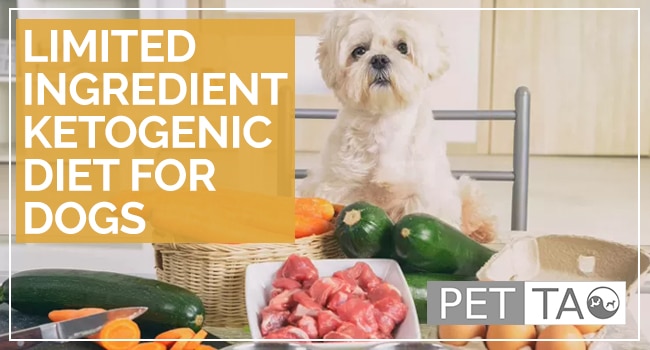Why Feed a Ketogenic Diet for Dogs?
You may be interested in a ketogenic diet for several different reasons.
You may feel feeding a ketogenic diet is a more “primal diet” for your dog. You believe feeding accordingly will keep your dog healthier.
Other times, you may choose a ketogenic diet to help with specific health challenges like diabetes, seizures, or cancer.
We feel feeding dogs an energetically appropriate diet is best for pets, even when you choose to feed in ketogenic ratios.
Below is the recipe for a limited ingredient ketogenic diet for dogs.
Why Choose a Limited Ingredient Diet?
A limited ingredient diet is great for dogs with allergies or food sensitivities. It is a fantastic tool to help dogs who:
- Suffer from hot spots or red skin
- Scratch vigorously
- Deal with breathing or skin allergies
- Lick or chew their feet
- Shake their head often from ear infections
How to Cook a Limited Ingredient Ketogenic Diet for Dogs
One simple way of thinking about a ketogenic diet is that it has a higher fat and a much lower carbohydrate content than regular dog diets. A ketogenic diet contains:
- 47%-57% Fat
- 28% -38% Protein – mostly from meat
- A maximum of 15% Carbohydrates
The list below contains foods that are neutral and cooling. These ingredients are less likely to cause a heat reaction in dogs. However, please do not use any food you suspect your dog is allergic to. To keep the recipe low-allergen, you must limit the ingredients to one protein source and two vegetable sources per batch. Our favorite protein source is turkey. We’ve found it less likely to cause a reaction in most dogs.
An easy way to track the exact protein, carbohydrate, and fat ratios of the new recipes you come up with is with an online food calculator. You can find online food logs in websites like Fitbit and Livestrong.
Remember, the key to a successful limited ingredient diet is keeping the number of ingredients to a minimum. Choose no more than one (1) protein source and two (2) vegetable sources.
We also recommend using coconut oil as the fat choice, as coconut oil naturally contains 45% – 65% MCTs, aiding ketosis and preventing seizures.
Flaxseed oil is also an excellent addition to the recipe. Flaxseed oil is high in Omega-3s, which are anti-inflammatory. Actually, fish oil is a better source of Omega-3s, but you can’t cook fish oil because it degrades during cooking. However, you could add fish oil as a topper or to the recipe after cooking.
You can further increase your dog’s MCT intake by purchasing a canine MCT supplement and following the dosing instructions on the label.
Limited Ingredient Food List
Reminder: As mentioned earlier, we prefer turkey as a protein source as it is less likely to cause a reaction.
Meats/Protein Source
Carp (neutral) Clam Cod Crab Duck Eggs (neutral) Goose (neutral) Herring (neutral) Kidney, pork (neutral) Liver, beef (neutral) Liver, sheep Mackerel (neutral) Oyster (neutral) Pigeon (neutral) Pork (neutral) Quail (neutral) Rabbit Sardine (neutral) Tofu Turkey Tuna (neutral) Whitefish (neutral) Yogurt
Vegetables
Alfalfa Artichoke (neutral) Asparagus (neutral) Broccoli Cabbage (neutral) Carrot (neutral) Cauliflower (neutral) Celery Cucumber Dandelion leaf Eggplant Lettuce Mushroom, button Spinach Summer squash Swiss chard Tomato
Fats
Nuts Seeds Olive oil Flaxseed oil
Sample Limited Ingredient Ketogenic Dog Food Recipe
To make the recipe at home, you will need:
- 5 pounds meat (see “protein” list above)
- 1.5 pounds of vegetables (see “vegetable” list above)
- 1 egg
- 4 tablespoons of olive oil or flaxseed oil
Directions:
First, debone and chop meat and vegetables.
Next, place all ingredients in the crockpot layering:
- Slow-cooking root vegetables on the bottom
- Meat in the middle
- Fast-cooking items on top
Then, top with 1 cup of water.
Afterward, cook on low for 4 hours.
In addition, add the following to your pet’s diet:
- One canine multivitamin per day.
- Calcium supplement 22mg/lb of body weight per day. Some other good choices for calcium are eggshell powder or bone meal. If using bone meal, please note the calcium content and calculate 22mg/lb of body weight from the calcium content, not the overall bone meal content.
Feeding Schedule:
- Feed roughly 1.5 cups per 25 pounds of body weight twice daily.
- Monitor your pet’s weight. If an undesirable weight loss occurs, please contact your veterinarian immediately so that you can adjust the feeding plan.
References:
- Use TCVM Food Therapy to Energetically Balance Your Pet https://pettao.com/pet-food-recipes
- Dietary intervention for canine epilepsy: Two case reports: Dietary Intervention for Canine Epilepsy: Two Case Report https://www.ncbi.nlm.nih.gov/pmc/articles/PMC6398089/
- Veterinary Practice News https://www.veterinarypracticenews.com/ketogenic-diet-zonisamide-ease-seizures








